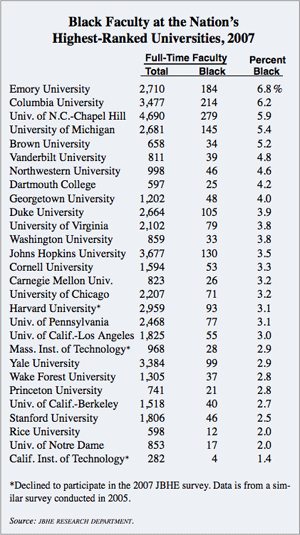|
Black Faculty in Higher Education: Still Only a Drop in the Bucket JBHE surveyed the nation’s highest-ranked research universities, the most selective liberal arts colleges, and the 50 flagship state universities to determine their levels of black faculty. Overall, the liberal arts colleges have the most racially diverse faculties. Mount Holyoke College had the highest percentage of black faculty of any of the 100 colleges and universities surveyed. Nationwide, just over 5 percent of all full-time faculty members at colleges and universities in the United States are black. This percentage has increased slightly over the past decade. But the percentage of black faculty at almost all the nation’s high-ranking universities is significantly below the national average of 5.2 percent. JBHE recently surveyed the nation’s highest-ranked universities to determine the number and percentage of blacks on their faculties. We received responses from 26 high-ranking universities. MIT and CalTech declined to provide updated data on their black faculty.* This Year’s Results
In both our 2005 and 2002 surveys, Columbia University had the highest percentage of black faculty. This year, Columbia drops to second place. At Columbia, 214 of the 3,477 faculty members are black. But it must be noted that a large majority of Columbia’s black faculty members are in its graduate and professional schools. After conducting our earlier survey, Columbia professor Manning Marable advised JBHE that of the 400 professors with tenure at the Columbia College of Arts and Sciences, only five were black. The 279 black faculty members at the University of North Carolina made up 5.9 percent of the full-time faculty, the third-highest level in our survey. In total numbers, Chapel Hill had the most black faculty members. At the University of Michigan, there are 145 black full-time faculty. They make up 5.4 percent of the full-time faculty on the Ann Arbor campus. Brown University is the only other high-ranking research university where blacks are at least 5 percent of the total full-time faculty. At 21 of the 26 universities that responded to our survey, the black percentage of the total faculty was below 5 percent. At Notre Dame, Stanford, Berkeley, Princeton, Wake Forest, and Yale, blacks are less than 3 percent of the total faculty. At MIT and CalTech — two universities that chose not to participate in this year’s survey — blacks made up less than 3 percent of their faculties in 2005. It is difficult to determine why there are such wide institutional disparities in the numbers of black faculty. Certainly, the very small number of blacks pursuing Ph.D.s in engineering and the natural sciences is mirrored in the low percentages of black faculty at science-oriented institutions such as Carnegie Mellon University and Johns Hopkins University. As expected, institutions with high percentages of black faculty have characteristically shown a commitment to hire African Americans to junior faculty positions. Emory University in Atlanta has a strong record in hiring black junior faculty. But many of the Ivy League colleges tend to do lateral hirings of established African-American academics from other institutions. Overall, it appears that results largely depend on whether the faculties that control hiring at particular universities have a strong commitment to developing a racially diverse teaching corps. Much depends, too, on who has the power to hire faculty. At most prestigious universities the authority to engage faculty tends to be lodged in the departments concerned. University presidents and deans have little or no say in the hiring process. At best they can cajole members of the various departments involved or provide monetary incentives to hire black scholars. Faculty departments traditionally explain their poor performance on the grounds that there are no qualified African Americans in the Ph.D. pipeline. But the fact that many of our great universities have been highly successful in recruiting African-American faculty tends to show that the “no blacks in the Ph.D. pipeline” thesis is at worst a red herring and at best a weak explanation for poor results. Black Faculty at the High-Ranking Liberal Arts Colleges
Mount Holyoke College in Massachusetts has 18 black faculty members. They make up nearly 10 percent of the college’s entire full-time faculty. Haverford College, which led our previous survey, ranked second with a faculty that is 8.6 percent black. At Swarthmore College in Pennsylvania, blacks are nearly 7 percent of the total faculty. Bowdoin College and Harvey Mudd College each had only one black faculty member. Claremont McKenna College, which is the only highly selective liberal arts institution to decline to participate in this year’s survey, had two blacks on its 126-member faculty in 2005. Black Faculty at the Nation’s Flagship Universities Now we turn to the number of black faculty at the nation’s 50 flagship universities. A few highlights: The University of North Carolina at Chapel Hill, the University of Maryland, Ohio State University, the University of Michigan, Pennsylvania State University, the University of Georgia, and the University of Florida are the only flagship state universities that have more than 100 black faculty members. At the other extreme, in 2007 the University of South Dakota and the University of Maine had only three black faculty members. The University of Idaho, the University of New Hampshire, the University of Montana, the University of Wyoming, and the University of North Dakota had fewer than 10 black faculty members. In 2007, five blacks were teaching at the University of Montana. In the year 2001, there were no black faculty at the university. Actual numbers of black faculty members may be deceiving because there are huge differences in the size of the flagship state institutions. Therefore, a more meaningful way to compare these institutions regarding their black faculties is to see what percentage of their total faculties are black. Using this measurement, we find that the University of North Carolina has the highest percentage of black faculty among the flagship state institutions at 5.9 percent. In our 2005 survey the University of Alabama had the highest percentage of black faculty. The only other flagship state universities where blacks make up at least 5 percent of the total full-time faculty are the University of Georgia, the University of Michigan, the University of Maryland, and the University of Mississippi. Comparing Black Faculty to the Black Population in a Particular State The University of North Carolina at Chapel Hill leads all flagship state universities in the total number of black faculty as well as the percentage of all faculty who are black. But when one considers the fact that more than 21 percent of the population of the state of North Carolina is black, an African-American faculty of a mere 5.9 percent is not an extraordinary accomplishment. Therefore, we believe that a far more useful ranking of the flagship state universities is to compare their percentage of black faculty to the percentage of blacks in the population, and thus the work force of a given state. Under this ranking system, the University of North Carolina is near the bottom of the list, not the top. There are five state flagship universities at which the percentage of black faculty is greater than the percentage of the black population in the state. All of these five states have small black populations. They are Vermont, Montana, North Dakota, Wyoming, and Utah. At the University of Idaho, blacks make up one percent of the faculty, the exact percentage of blacks in the state’s population. Among the states with a significant black population of greater than 5 percent, the University of Massachusetts ranks the highest when we compare the level of black faculty to the black population of the state. Blacks make up 4.5 percent of the faculty at UMass whereas blacks are 6.9 percent of the state’s population. Among the southern and border states, Kentucky has the most favorable ratio of black faculty at its state flagship university to the black population of the state. Louisiana State University ranks at the bottom among the southern states. In a state where the black population exceeds 33 percent of the total, only 3.4 percent of the faculty at LSU is black. *For the purposes of our survey we requested data for all full-time faculty but excluding medical school faculty. Large research universities that have affiliated medical schools often have hundreds of practicing physicians on their faculty roles who do little or no classroom teaching. |
|




 Of the 26 high-ranking universities that responded to our survey this year, blacks made up more than 5 percent of the total full-time faculty at only five institutions. Emory University in Atlanta has the highest percentage of black faculty at 6.8 percent.
Of the 26 high-ranking universities that responded to our survey this year, blacks made up more than 5 percent of the total full-time faculty at only five institutions. Emory University in Atlanta has the highest percentage of black faculty at 6.8 percent.  The nation’s most highly selective liberal arts colleges have a far superior record in hiring black faculty than the nation’s most prestigious research universities. Of the 24 high-ranking liberal arts colleges responding to our survey, nine had black faculty levels of 5 percent or more.
The nation’s most highly selective liberal arts colleges have a far superior record in hiring black faculty than the nation’s most prestigious research universities. Of the 24 high-ranking liberal arts colleges responding to our survey, nine had black faculty levels of 5 percent or more.